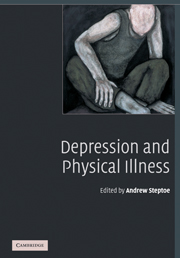Book contents
- Frontmatter
- Contents
- List of contributors
- Preface
- Part 1 Introduction to depression and its determinants
- Part 2 Depression and specific health problems
- 3 Depression and the development of coronary heart disease
- 4 Depression and prognosis in cardiac patients
- 5 The management of depression in patients with coronary heart disease
- 6 Depression and physical disability
- 7 Chronic pain and depression: twin burdens of adaptation
- 8 The interrelationship of depression and diabetes
- 9 Depression and chronic fatigue
- 10 Cancer and depression
- 11 Depression and obesity
- Part 3 Biological and behavioural processes
- Part 4 Conclusions
- Index
- References
4 - Depression and prognosis in cardiac patients
from Part 2 - Depression and specific health problems
Published online by Cambridge University Press: 17 September 2009
- Frontmatter
- Contents
- List of contributors
- Preface
- Part 1 Introduction to depression and its determinants
- Part 2 Depression and specific health problems
- 3 Depression and the development of coronary heart disease
- 4 Depression and prognosis in cardiac patients
- 5 The management of depression in patients with coronary heart disease
- 6 Depression and physical disability
- 7 Chronic pain and depression: twin burdens of adaptation
- 8 The interrelationship of depression and diabetes
- 9 Depression and chronic fatigue
- 10 Cancer and depression
- 11 Depression and obesity
- Part 3 Biological and behavioural processes
- Part 4 Conclusions
- Index
- References
Summary
Coronary heart disease (CHD) is the leading cause of death in the USA and Europe [1, 2]. In roughly half the cases, the first clinical manifestations of CHD – myocardial infarction (MI) or sudden death – are catastrophic. These events are sudden, unexpected and unpredictable. The economic cost of CHD is growing. For example, in the USA over $130 billion is spent on CHD each year in direct medical costs, disability payments and lost productivity [2]. Moreover, traditional risk factors such as cigarette smoking, hyperlipidaemia and hypertension do not account fully for the timing and occurrence of these events.
Depression is also a major health problem. It is associated with significant impairment of function, which may, at times, be worse than that of chronic medical disorders [3]. Depressive symptoms have been correlated with the presence of one or more chronic diseases [4, 5], as well as inability to work [6], days in bed or days away from normal activities [4], increased mortality risk [7], increased use of medical services [8], and decreased wellbeing and lowered functioning [3]. Major depressive disorder (MDD) is the most prevalent of all psychiatric disorders, affecting up to 25% of women and 12% of men during their lifetime [9]. Since 1950, the prevalence of depression has increased significantly [10].
Depression is disproportionately prevalent among cardiac patients, with estimates of MDD of about 15% in patients following acute myocardial infarction (AMI) or coronary artery bypass graft (CABG), and an additional 20% with either minor depression or elevated levels of depressive symptoms as measured by questionnaires such as the Beck Depression Inventory (BDI) [11–17].
Keywords
- Type
- Chapter
- Information
- Depression and Physical Illness , pp. 87 - 108Publisher: Cambridge University PressPrint publication year: 2006
References
- 5
- Cited by



